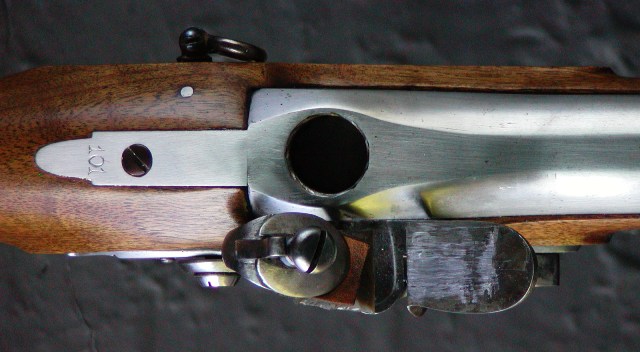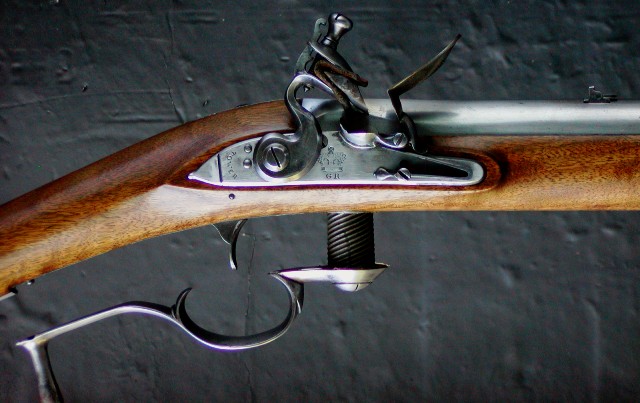How about one “accurate shot” ever 13.6 seconds…
For 5 minutes…
Frontier Culture: The Last of the Leatherstockings
All outdoorsmen dream of the frontier. A few still live it.
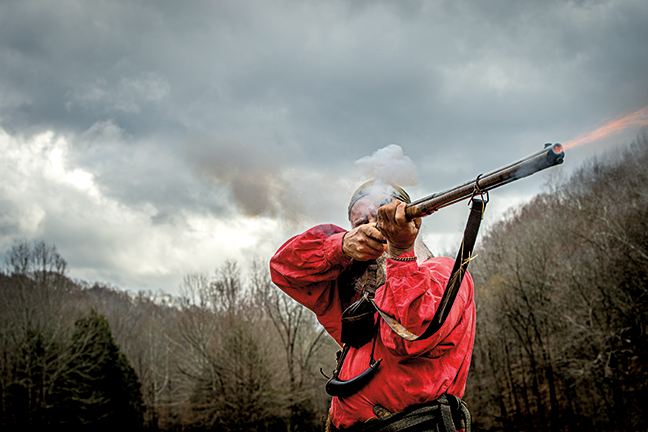
Photo Credit: Bill Konway
August 30, 2018By Joseph von Benedikt
Frost Blanketed the Fort Bridger, Wyoming, landscape, and tendrils of morning fog drifted across the firing line. Competitors, all wearing the traditional garb of mountain men, were lining up for a muzzleloading smoothbore match, topping off powder horns and checking gear. When the starting buzzer sounded, more than 40 shooters dropped behind a two-foot-high buck fence, slid the long barrels of their flintlock rifles over the top, and fired at targets 25 yards distant.
Against a five-minute clock, the shooters hunkered behind the fence, reloading as fast as possible, firing, and reloading again. Near the middle of the line, one man worked like a finely tuned machine, loading and firing at least twice as fast as the rest. While most of the shooters' roundballs scattered across their targets like a handful of thrown rocks, his created a jagged hole in the center. Each scored 10 points. Incredibly, 22 roundballs followed each other through that center before the bell sounded.
The Mountain Man
Born in the late 1940s in rural Tennessee, Steve Baxter spent most of his time in the woods with his cousins.
"Jim Bowie, Tarzan, Davy Crockett. All them shows were always on TV," Baxter said. "We packed along throwing knives and hatchets, made our own bows and arrows." Baxter pronounced it "arrers" with a strong southern drawl. "Wadn't no deer in Tennessee back then, but we hunted a lot of rabbits and squirrels."
During high school and then a stint in the Navy as a jet mechanic, Baxter became immersed in building drag cars and racing. For a while he co-owned a shop that specialized in Harley Davidson motorcycles. Eventually, he burned out on motorsports and returned full circle to his roots: hunting and trapping in Tennessee's backwoods
ADVERTISEMENT
SCROLL TO CONTINUE WITH CONTENT
New Hobbies
While attending trapping conventions in the 1970s, Baxter encountered a blossoming rendezvous scene. He began building throwing knives and tomahawks and competing with them — and his extraordinary hand-eye coordination manifested. "I won every time," he chuckled. "Just wadn't anybody could beat me!"
I've seen Baxter walk 30 or 40 feet back from a tomahawk block, turn, and throw two tomahawks at the same time — one from each hand — into the center of the block. He could just about call which spot on a playing card he'd drive his knife into.
Photo Gallery
See all Photos

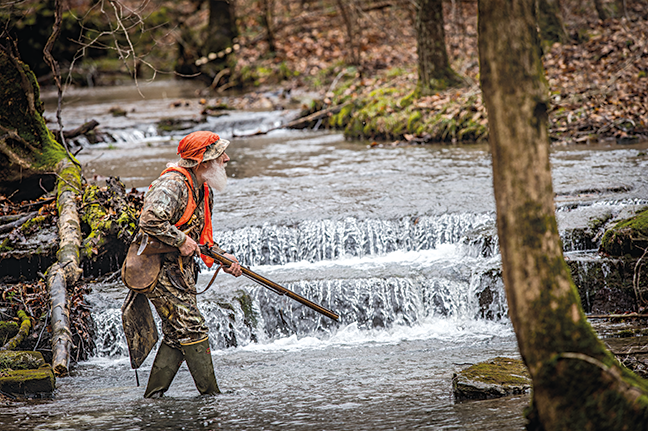
An old Navy buddy gave Baxter a .36-caliber Dixie Gun Works Pennsylvania longrifle kit. Back then, kits didn't always come with instructions.
"Took a long time to figure out how to build it," Baxter said. "Nobody knew much about 'em at that point. Once I got it together, I tried to shoot a squirrel straight above my head. The rifle didn't go off, and all the powder fell out of the pan right into my eye! I quickly figured out how to tune them locks and flints to make 'em go off."
Video That May Interest You
00:1704:55
And make 'em go off he did. His flintlocks have none of the discernible delay usually associated with flinters. No scratch-bang, just a swift shwam.
Baxter struck up a deep friendship with traditional riflesmith Jack Garner and began traveling with him to major shoots. At his first visit to the Nationals in Friendship, Indiana, Baxter competed only in the knife and 'hawk throws, winning both and starting a 12-year run of championships.
"That first trip, I wandered over and watched the smoothbore shooting," Baxter said. "I didn't know much about smoothbore at that point, but I'd done some shotgun slug shooting and just knew I could do a lot better than them guys shooting them big targets."
The Flintlock Builder
As he became more immersed in the traditional muzzleloading world, Baxter built a switch-barrel .54 with one rifled and one smoothbore barrel. Intrigued by the challenges and possibilities presented by flintlock smoothbores as a versatile tool for hunting and competitive shooting, Baxter began working with his, learning to tune point of impact and extend lethal shot-pattern distances. He discovered tightly wrapping a section of the barrel near the rear ramrod thimble with string tuned the harmonics of his smoothbore barrel and made it more accurate. "Off the bench at 25 yards, that gun put bullets almost in the same hole."

Photo Credit: Bill Konway
Eventually, his flintlocks settled into a type those familiar with them call a "Baxter gun." More or less an early Virginia style, the gun features a handtuned Siler flintlock, a half-octagon half-round 42-inch barrel, handmade single trigger, and handforged hardware. Wood and metal finishes are rustic and period correct. Decoration is minimal, but the mechanical tuning is a work of art.
Baxter's flintlocks were made to perfection, and he began winning the smoothbore matches he entered.
"I got possessed with muzzleloaders," Baxter chuckled. "I've got my own farm with my own shooting range. I'd go down there about three days a week and shoot a pound of powder. I used to shoot 150 pounds of blackpowder per year.
"If I was shooting bad, I'd keep after it to fix the problem. If I was shooting good, I had so much fun I couldn't quit. Got to the point where I was shooting offhand better than most folks can shoot off a bench. One time I shot five offhand shots into less than two inches at 100 yards. Got to where the shots just seemed to fall in there."
Baxter was arguably in his prime — in terms of shooting ability — when I got to know him. He was old enough to be well seasoned against the pressures of competition and young enough to still be athletically formidable in timed, cross-country-type matches such as the Seneca Run, which can require shooting, primitive-method fire starting, knife and 'hawk throwing, trap setting, archery, and several other traditional skills along a long trail and against the clock.
He didn't give up throwing his handmade blades. He won every time he entered the knife and 'hawk throw at the Winter Nationals in Arizona. "I think the farthest that I've consistently thrown was 192 feet," Baxter said, then grinned. "I can't always stick a playing card that far away."
The Hunter
Almost 30 years later, most of Baxter's shooting involves whitetails, turkeys, or small game. He's taken dozens of deer through the years with flintlock rifles, smoothbores, and pistols. For one 10-year stretch he hunted with flintlocks only. In 2016, he realized a major goal, shooting a big whitetail behind the log cabin he built in the Tennessee backwoods.
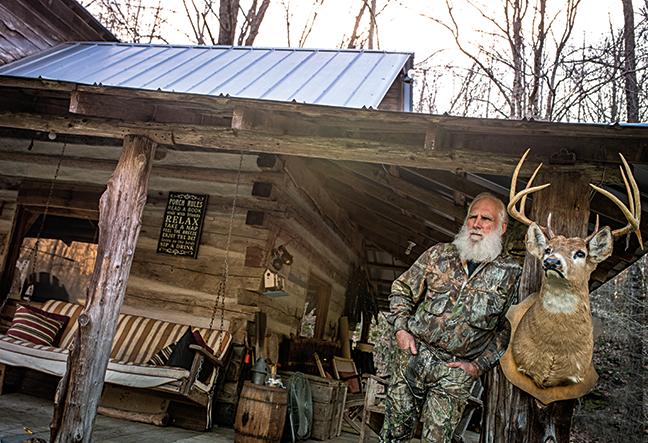
Photo Credit: Bill Konway
The highlights of his hunting career, Baxter said, were trips to hunt southern Utah's elk and mule deer country with my brother and me in the mid-'90s. At the time, Utah tags were still easy to get, and elk were wild and scarce. Not to worry. He heart shot a big cow elk at 170 yards. Offhand. With a flintlock. A few years later he returned, stalking within 60 yards of a 4x4 muley before putting a .54 roundball squarely through its boiler room.
Tips from the Expert
"Know your gun." Baxter said when asked how hunters can be better flintlock shooters. "And practice holding it a lot. At home, just stand and aim it, like strength training. Do a lot of dry-firing and learn to hold that gun still through the shot. You got to see that bullet hole in your target before you move the gun."
Keep in mind that almost all muzzleloading matches are traditionally shot from the offhand position, in traditional garb. Locktime is measured in tenths of seconds rather than thousandths. A clean trigger squeeze and follow-through are all-important.
"I had really good guns, too," Baxter added. "Good barrels, good solid locks. That's important. Get a good, well-built lock, take it apart, and polish it up. I like a real light frizzen spring; they're a lot easier on your flint. And keep 'em clean."
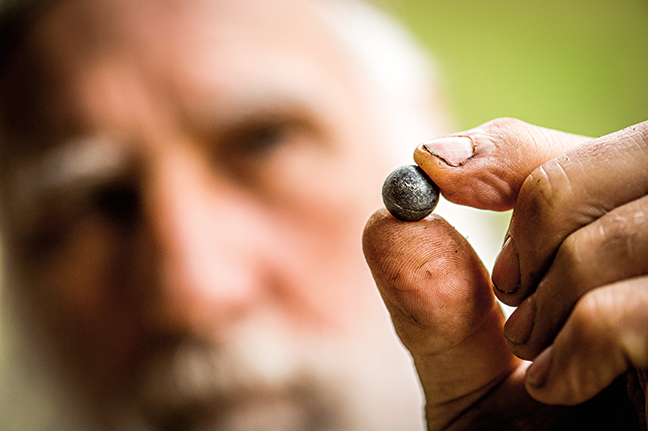
Photo Credit: Bill Konway
Most guys can't get really tight groups from a flintlock, let alone a smoothbore. In addition to skill, Baxter achieves great accuracy with traditional components and techniques.
"I like a tight, cotton drill patch, about 18 thousandths thick. For shootin' at the range and in matches, just use a spit patch. As long as you don't wait too long between shots — which lets the fouling dry out and get hard — you can keep shooting all day without cleaning.
"For hunting, I use bear oil on my patch. And I use bear oil inside my barrel after cleaning and to wipe the exterior of the gun down with. It's a really good traditional preservative.
"As for blackpowder, I like FFFg granulation in everything but my 10-gauge turkey gun. It burns a little cleaner than FFg, and it's hotter, so you don't need as much. I use home-cast or store-bought .530-diameter balls in my rifles and .525 balls in the smoothbores. A .54-caliber smoothbore is real close to a 28 gauge, by the way."
While he's taken quite a few gobblers with his 28-gauge smoothbores, he prefers a 10-gauge flintlock built specifically
for "killin' turkeys." It's got one concession to progress: screw-in chokes. "It'll shoot with any modern gun," Baxter stated. "I've patterned it, and 40 yards is pretty much a sure thing."
Baxter uses Murphy's Oil Soap to clean with after a shooting session. "Mix a cup of Murphy's Oil Soap with a cup
of Mr. Clean household cleaner in a 64-ounce dish soap container, then fill it up with auto windshield washer fluid. Mix it good. Then you've got a squeeze bottle of cleaning solution."













